Unearthing ESG in the Gold Industry
15 May 2019
Easing Global Risks Softened Safe-Haven Demand
The gold price showed a small decline in April as global risks eased somewhat. First quarter gross domestic product (GDP) growth exceeded expectations in the U.S. and China. China also reported gains in retail sales and industrial production for March. Meanwhile, European Union (EU) leaders kicked the can down the road by giving Britain another six months to figure out a Brexit plan. The S&P 500® Index1 celebrated with a new all-time high on April 29. According to Gluskin Sheff2, companies bought back a record $800 billion of stock in 2018 and stock repurchases have soared 22% in the first quarter of 2019. It looks like corporate tax cuts and debt have fueled much of the stock market euphoria. The U.S. dollar was also strong, as the US Dollar Index (DXY)3 rose to its highest level in nearly two years.
A lack of safe-haven demand resulted in outflows from global gold bullion exchange traded products. Gold ended the month at $1,283.55 per ounce for an $8.75 (0.7%) loss. Gold stocks saw profit-taking in April after rising to yearly highs in February and March. NYSE Arca Gold Miners Index4 declined 6.8% and MVIS Global Junior Gold Miners Index5 fell 7.6%. Companies are in the midst of first quarter reporting and, so far, results have been good. However, Newmont Mining (6.0% of net assets) has found some unexpected operating difficulties at two of the mines it recently acquired in the Goldcorp merger — an underground fire in Canada and a labor stoppage in Mexico. We expected the integration of the Goldcorp assets would be challenging, but we also believe Newmont has the skills to turn them around.
Mixed Signals on Economy
While U.S. GDP growth of 3.2% beat all analyst expectations, the underlying report left much to be desired. Much of the gain was in volatile inventories, trade, and government spending, whereas core growth in consumer spending and business investment fell. Meanwhile, residential housing continued to be a drag on GDP growth. Despite the stock market highs, the economy is not firing on all cylinders. The potential for weak economic results and stock market volatility may provide a better environment for gold and gold stocks as 2019 unfolds.
ESG and Gold Mining
Socially responsible, sustainable, and environmental, social and governance (ESG), are all themes that are being incorporated into investment decisions by many funds around the world. In fact, there are now funds that invest solely on ESG performance. As the sustainability movement has gained momentum over the past several years, we have found ourselves wondering what all the fuss was about. The gold industry has learned the hard way over the years that shareholders are not the only stakeholders who should benefit from a gold mine. Other stakeholders who are equally important include employees and their families, local communities or tribes, state/provincial and national governments, and the environment. Failure to treat all stakeholders fairly can hamper or even shut down an operation, with loss of jobs and income for all.
Unfortunately, the image much of the investing public has of mining comes from accounts of artisanal or small-scale mining, headline disasters, and historic and outdated mining practices. Here, we discuss each of these in detail, along with further sustainability efforts:
Artisanal Mining — Artisanal and small-scale mining (ASM) have become a problem in many countries where it causes losses in tax revenue, crime, and pollution. Most ASM is illegal, so the gold is traded on the black market. A recent Reuters article6 suggests that much of the ASM gold originating in Africa finds its way to the United Arab Emirates (UAE) for refining and further distribution. The volume has risen from 67 tonnes in 2006 to 446 tonnes in 2016. Metals Focus estimates that ASM production totaled 550 tonnes in 2018, equivalent to 15% of global mine supply.7 The increase is due to a gold price that has doubled since 2006, population growth, lack of economic opportunities, and cell phone technologies that facilitate communications and payments. Countries with limited means find ASM difficult to monitor or regulate. Artisanal camps can spring up overnight once gold is discovered.
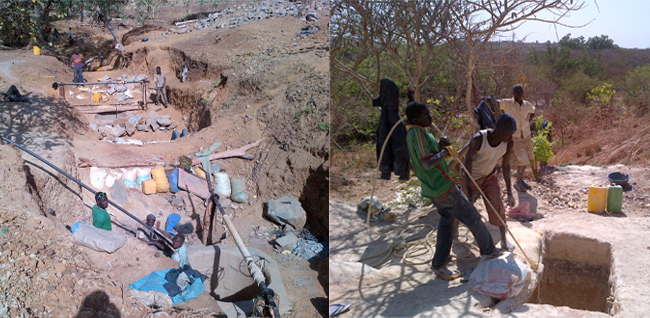
Artisanal mining, Burkina Faso (Source: VanEck, 2014)
These photos show typical African artisanal operations, with men and sometimes women working to earn a living for their families, often at better wages than in traditional trades.
ASM is also prevalent in South America and is now widespread and lucrative enough to attract the attention of criminal enterprises. Cartels, gangs, militias, and terrorists are increasingly exploiting ASM to fund their activities.
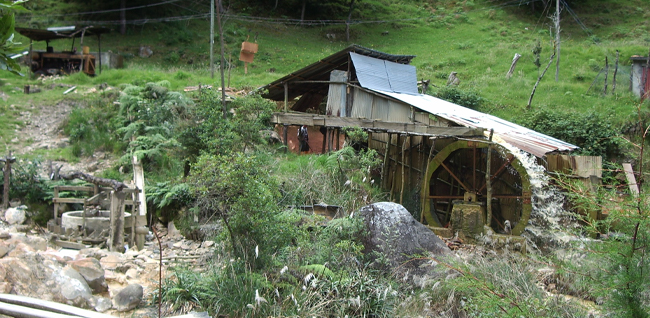
Small scale milling operation, Colombia (Source: VanEck, 2009)
ASM operations use gravity to separate coarse gold from the ores. Pure gravity separation is environmentally benign, however, this is often followed by chemical solution to extract fine-grained gold. This requires the use of mercury or cyanide that is subsequently discarded into the environment.
Modern commercial gold mining and the companies in which we invest have nothing to do with ASM mining. Most ASM deposits are too small to be of interest to a commercial operation. However, companies sometimes discover an economic deposit in an area of ASM mining. In such cases, the mining company is usually able to clean up the environmental damage and become a place of legal employment for many ASM miners. In addition, with the assistance of national police or military, organized crime can be driven out.
Headline Disasters — The failure of a tailings dam at an iron ore mine in Minas Gerais, Brazil made global headlines earlier this year. Like any industrial activity, mining has risks that can result in damage, injury, or death. Lost in the rage of disaster is the fact that there are thousands of tailings facilities around the world that have been properly designed and constructed. Gold mines tend to be smaller and without the massive facilities needed by iron or copper mines. Hopefully the Brazilian tragedy brings a new focus among mining companies that makes tailings failures obsolete.
Underground coal mines also make headlines due to health and mining risks that are unique to coal deposits. Ground control and ventilation is more manageable in underground gold mines than with coal for many reasons (not least of which being relative rock strength). In my career, I honestly cannot remember any catastrophic environmental or health failures in the gold mining industry. Unfortunately, the image of all miners suffers when one fails.
Historic Mining — Many of the superfund8 sites in the U.S. are abandoned pre-World War ll mining operations that destroyed the landscape and left acid-generating waste piles and mine workings to pollute waterways with toxic metals. This is the image of mining that environmental extremists and anti-mining NGOs portray to the public. However, the regulatory framework now in place globally makes it virtually impossible to construct an operation that would do such damage. Companies undertake a tremendous amount of drilling, testing, engineering, and metallurgical work that results in life-of-mine plans that return the landscape to as close to its original state as possible. This before and after photo is a reclaimed Newmont gold mine in Indonesia. Notice that the process facilities, buildings, and other infrastructure are removed for sale or recycling. The roads and dumps are contoured to match the topography. Finally, topsoil stockpiled for closure is spread and the area is reseeded with native vegetation.
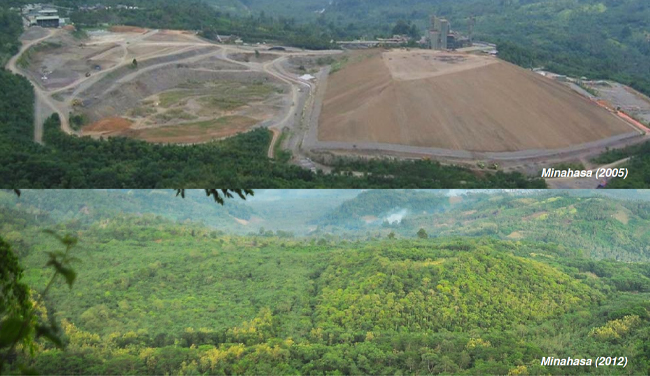
Minahasa mine waste dump and plant area, Indonesia (Source: Newmont, 2018)
Sometimes historic mining properties are found to contain economic deposits either under current market conditions or with additional drilling. In such cases, a company can incorporate remediation into its life-of-mine plans. Junior developer Midas Gold (0.3% of net assets) has submitted plans to the U.S. Forest Service to re-develop the Stibnite mine in Idaho. If approved, these plans will properly dispose of historic tailings and salmon runs ruined by mining will be restored.
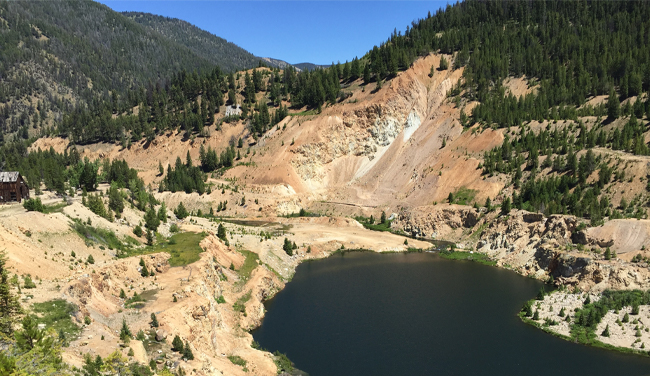
Historic Stibnite Mine, Idaho (Source: VanEck, 2016)
Social Responsibility — Gold companies tend to operate in remote corners of the planet. They are good at mining, but not so good at media relations. Far from the glare of mainstream media, their untold story is the positive impact on the communities and countries in which they operate, in our view. We have been incorporating environmental and social issues in our investment process since long before ESG became a buzzword. Our evaluation includes visiting sites to see activities. Employment opportunities, infrastructure improvement, and better health and education are some of the benefits mining operations provide. At the Kibali mine in eastern Democratic Republic of Congo (DRC), Randgold (now Barrick – 6.9% of net assets) had a relocation program that moved people from mud huts to concrete housing with a kitchen area, toilet, electricity, and a clean reliable water source. While it may not seem like much to Western eyes, this is activity that transforms the lives of a community.
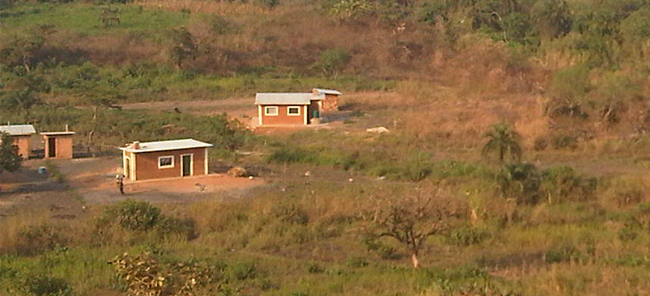
Kibali mine area housing, Democratic Republic of Congo (Source: VanEck, 2012)
Gold mines do not last forever, so some companies attempt to establish sustainable employment once the mine shuts down. Junior producer Golden Star Resources (0.7% of net assets) has initiated a number of entrepreneurial business efforts near its operations in Ghana. It observed that eggs were trucked into the area every day and so taught egg farming skills to local residents. They are also experimenting with pig farming and possibly fish farming in lakes of abandoned open pit mines. The company found palm trees grow very well on old tailings sites. When the trees in the photo below reach four years of age, they will begin bearing fruit for palm oil production. This, along with plantations on land provided by the local chief, currently employs 700 people.
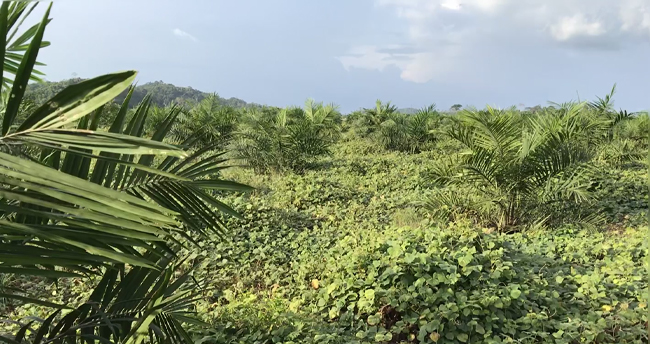
Reclaimed Golden Star mine tailings facility, Ghana (Source: VanEck, 2018)
These are just a few examples of gold company activities that we find compelling. Technological advances are also enabling some mines to convert energy needs to solar, wind, or natural gas when economically feasible. There are also broad efforts to reduce fresh water use and greenhouse gas emissions.
All company, sector, and sub-industry weightings as of April 30, 2019 unless otherwise noted.
1S&P 500® Index (SPXT) is an American stock market index based on the market capitalizations of 500 large companies having common stock listed on the NYSE or NASDAQ.
2Gluskin Sheff + Associates Inc., a Canadian independent wealth management firm, manages investment portfolios for high net worth investors, including entrepreneurs, professionals, family trusts, private charitable foundations, and estates.
3U.S. Dollar Index (DXY) indicates the general international value of the U.S. dollar by averaging the exchange rates between the U.S. dollar and six major world currencies.
4NYSE Arca Gold Miners Index (GDMNTR) is a modified market capitalization-weighted index comprised of publicly traded companies involved primarily in the mining for gold.
5MVIS Global Junior Gold Miners Index (MVGDXJTR) is a rules-based, modified market capitalization-weighted, float-adjusted index comprised of a global universe of publicly traded small- and medium-capitalization companies that generate at least 50% of their revenues from gold and/or silver mining, hold real property that has the potential to produce at least 50% of the company’s revenue from gold or silver mining when developed, or primarily invest in gold or silver.
6Reuters, “Exclusive: Gold worth billions smuggled out of Africa” (2019, April 23). Retrieved May 3, 2019.
7BullionVault, “’Informal’ Gold Mining ‘Now 15%’ of World Output” (2019, April 5). Retrieved May 3, 2019.
8Superfund sites are polluted locations requiring a long-term response to clean up hazardous material contaminations.
Important Disclosure
This is a marketing communication. Please refer to the prospectus of the UCITS and to the KID before making any final investment decisions.
This information originates from VanEck (Europe) GmbH, which has been appointed as distributor of VanEck products in Europe by the Management Company VanEck Asset Management B.V., incorporated under Dutch law and registered with the Dutch Authority for the Financial Markets (AFM). VanEck (Europe) GmbH with registered address at Kreuznacher Str. 30, 60486 Frankfurt, Germany, is a financial services provider regulated by the Federal Financial Supervisory Authority in Germany (BaFin).
The information is intended only to provide general and preliminary information to investors and shall not be construed as investment, legal or tax advice VanEck (Europe) GmbH, VanEck Switzerland AG, VanEck Securities UK Limited and their associated and affiliated companies (together “VanEck”) assume no liability with regards to any investment, divestment or retention decision taken by the investor on the basis of this information. The views and opinions expressed are those of the author(s) but not necessarily those of VanEck. Opinions are current as of the publication date and are subject to change with market conditions. Certain statements contained herein may constitute projections, forecasts and other forward-looking statements, which do not reflect actual results. Information provided by third party sources is believed to be reliable and have not been independently verified for accuracy or completeness and cannot be guaranteed. Brokerage or transaction fees may apply.
All performance information is based on historical data and does not predict future returns. Investing is subject to risk, including the possible loss of principal.
No part of this material may be reproduced in any form, or referred to in any other publication, without express written permission of VanEck.
© VanEck (Europe) GmbH / VanEck Asset Management B.V.
Sign-up for our ETF newsletter
Related Insights
Related Insights
20 January 2025
10 March 2025
14 February 2025
20 January 2025
18 December 2024
18 November 2024

